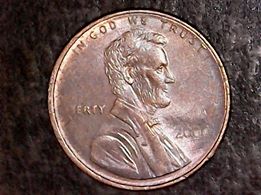The first, and most common in my opinion, would be the struck through grease error.
Minor ones are exceedingly common and don't really command any sort of premium, but extreme examples may bring a few dollars. The grease or combination of oil, grease and small metal shavings, fills the crevices in the die, causing the details of the coin to be thinner, mushy looking or even completely nonexistant.
Some struck through grease errors become popular because someone decides to give them a name. one such type is the Kansas Quarter "In God We Rust". In God We "Rust" has a following, which makes it slightly more desireable to collectors. This is a great picture to highlight what a struck through grease error looks like on a quarter. I see many people ask about these anomolies and usually never believe what I tell them. I have included an image with the area circled. You will see this many times on quarters, and many times it only causes this shadow like look without affecting any of the design elements. See pictures below. This example was found by Shane Daniel.
The next type, shown below, is what I would call "struck through" debris.
This type of struck through error is caused by small metal fragments in most cases, but sometimes the object just can;t be identified. In more extreme cases, the only way to tell the difference between this type of striek through and damage, is the check the reverse to see if there is any damage transfer or distortion opposite of the striek through.
The following types are more scarce in my opinion, meaning they are harder to find. I'm not going to get into the scarcity of each type because I just don't know.
Struck through wire.
This type is a little more hard to find and is easily missed. For some reason, small pieces of wire or event thread get into the process and cause indentations on the face of the coin when struck by the dies.
Struck through lamination or detached lamination.
Cents minted prior to 1983 and some other coins such as nickels and various foreign coins whose composition is an alloy mix, often times have lamination errors. Sometimes, these laminations detatch from the coins and get stuck in between the dies and the planchets. Sometimes, the lamination is from the very coin that is being struck.
Struck through a staple.
Yes, that is correct. Struck through a staple is also a type. Although, for the life of me, I can;t figure out what a staple would be doing in the minting process, but regardless, it happens. Sometimes, the staple stays attathced to the coin. Some say that this is not a staple, but rather a bristle from the wire brush used to clean the dies. I disagree with this, but who knows.
Struck through rim burr.
One that you won't see often is this type. I am not even sure how it happens or what causes it, but nonetheless, here it is. My guess is that either the planchet was damaged when going through the milling machine to form the rim, or maybe even when the planchet was punched out from the flat sheet of coin stock.
Struck through cloth.
Once again, this one you won't see often. I am assuming that pieces of cloth or rags that are used to clean some pieces of equipment tear off and are left behind and somehow find their way into the process. The results are amazing though.
Struck through a capped die.
This is my favorite struck through error type. I was lucky enough to find a few of these in the wild, and have even bought a few more. This happens when a coin or multiple coins get stuck on either the hammer(obverse) or anvil (reverse) die. The coin or coins that are stuck on the die are called a die cap. The dies continue to strike coins, but the result is a really strange looking coin. In early stages, the coin will appear to be uniface, with no image are almost no image. It can also have the distorted image of the reverse or obverse, whichever is the opposite side of the affected posrtion of the coin. In later stages, the details can be seen, but they are extremely distorted. This is not a die cap, this is a coin that his been struck through a die cap. In some cases, the coin is off center and only a small portion of the coin is sturck this way. A coin can also be struck then partially struck again with a capped die to create an indent due to the multiple striking chambers.


















































